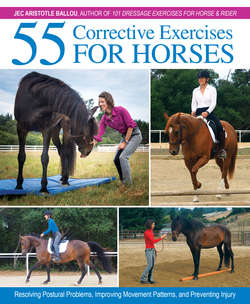Читать книгу 55 Corrective Exercises for Horses - Jec Aristotle Ballou - Страница 24
На сайте Литреса книга снята с продажи.
EXERCISE 10: Changing Angles, Leg-Yield
Оглавление| PURPOSE: | Encourages use of the oblique and intercostal muscles, improving balance and body control. |
By adjusting his body position while stepping sideways, the horse continues to recruit his oblique and intercostal muscles, which allow him to carry his barrel in a lifted and swinging manner—a requisite for movement to flow through his back. Asking him to make little shifts in his alignment helps him develop greater control over the slow twitch muscle fibers that create finely controlled foot placement and maneuvers of balance.
1 Riding your horse at a walk, turn him slightly toward your arena fence so that he is now in a head-to-fence leg-yield position—his haunches will be pointed inside the arena (fig. 1.12 A).1.12 A & B: I begin by asking Diamante to leg-yield along the rail in a marching walk (A). After several steps of leg-yield, I ask Diamante to move his haunches more away from my left leg and change his angle to the fence (B)…
2 His spine should make a 45-degree angle in relation to your fence.
3 Take several strides with exactly this angle.
4 Now, ask him to bring his haunches more to the inside of the arena, creating a 90-degree angle of his spine relative to the fence (fig. 1.12 B).
5 Side-pass (leg-yield) four or five strides with this angle (fig. 1.12 C).1.12 C: …and we arrive at a 90-degree angle to the fence, where we proceed in a few steps of side-pass.
6 Then return to the 45-degree angle for several strides.
7 Continue riding around your arena alternating between these two angles.
fit tip
Leg-yield and turn-on-the-forehand exercises mobilize the horse’s rib cage and activate the deep vertebral muscles. One of the prime benefits of lateral movements is the stretching effect of the middle gluteal muscle, encouraging relaxation of the extensor chain, and in turn, improving posture and promoting system-wide relaxation.
Be sure that you are riding only the two prescribed angles. The goal is to be very precise in these two angles and move swiftly from one to the other. You do not want the horse throwing himself around at random. Once you establish each angle, hold it very steady.
